This page gives you the latest on Taipei Cycle for the current year, 2024, and looks ahead to the next year 2025 as 2024 progresses.
We also include discussion and insight as to where the bicycle industry is headed generally as it evolves in the years ahead as that relates to Taipei Cycle as it evolves in tandem.
We’ll update the page regularly so bookmark it right now! (You’ll find info here that you can get nowhere else).
Besides covering important information for the current year, we’ll also include a select number of products for that year that we think are representative of a trend for that year, or are distinctive in some other way.
Contents
Taipei Cycle Overview
The first Taipei Cycle was held at the World Trade Center, Taipei’s Xinyi District in 1988 where it remained for the next two decades.
In 2008 the show moved to the Taipei Nangang Exhibition Center, or TaiNEX, a few kilometers to the east, although some booths continued to exhibit in the World Trade Center up until the Covid-19 enforced shutdown. (The Sports and Fitness Taiwan show, or TaiSPO continued to be held in the WTC, but moved to TaiNEX Hall 2 in 2023).
The Covid-19 pandemic saw the 2020 and 2021 events cancelled. Taipei Cycle returned in 2022, but Taiwan’s two week mandatory hotel quarantine period made it impractical for most foreign visitors to come to Taiwan. Thus the show that year was a low key affair. (Here’s a report on Taipei Cycle 2022 from the First Components newsletter . . . which you might want to subscribe to).
A digital version of Taipei Cycle, DigitalGO, was introduced in 2020 to make up for the lack of a physical show. The physical show is held across four days, from Wednesday to Saturday, whereas DigitalGO commences on the Wednesday and continues for the next four weeks.
Taichung Bike Week is more important for many B2B buyers than Taipei Cycle. Find out about it here.
Why Exhibit at Taipei Cycle?
A seemingly dumb yet important question.
You see, many companies that exhibit often do not get any new customers despite attending the show year after year.
Many of them have been attending the show since the first edition in 1988 and feel that not attending will raise doubts in the mind of observers as to the health of the business—they worry that suddenly not showing up one year will send a bad message to the industry whatever they may say publicly or privately to reassure their customers or the industry in general.
And for many, Taipei Cycle is the only form of marketing they engage in. They will argue with you that having a booth at the show is NOT a marketing tactic at all . . . they don’t do “marketing”. “Never have. Never will,” they say.
They see occupying a booth as a fundamental part of their annual business activities. That’s it.
An important reason for attending is, of course, the convenience of catching up with customers all in one place at one time.
And since B2B buyers and product managers have dealings with a number of suppliers, it’s a win-win for all concerned.
Still, there are companies who have chosen to give up their booth (see next section) at the show. They hire a nearby venue—a hotel suite in the style of Taichung Bike Week for example—and meet with customers and potential customers on an appointment-only basis.
Finally, yes, many exhibitors do generate leads and even contract orders with new and existing customers.
Nonetheless, every company should do a careful cost-benefit analysis of attending Taipei Cycle.
This is especially true in the digital era where, if you understand and practice correctly the fundamental principles of online marketing, you will massively cut your lead generation costs.
Getting a Booth
Demand for booths at Taipei Cycle is high.
For a company that has not exhibited before it’s a matter of get in line and endure a lengthy waiting period before a small booth will eventually be allocated. (Or you can share booth space with an existing exhibitor which is the way many companies attend their first Taipei Cycle).
Vacancies appear if an existing exhibitor skips a year, or drops out altogether.
Existing exhibitors who skip a year loose points they have earned over their previous years of occupying a booth at Taipei Cycle, sort of like a loyalty program—an absence or two will see them forfeit most of their points, and if they are not careful they may end up back in the queue vying with newcomers for a place.
Specialty Clusters and National Clusters
Booths at Taipei Cycle are located on the 1st and 4th floors and are allocated to one of two main categories: bicycle component speciality or national affiliation.
Specialty Clusters
Complete Bicycles are mainly to be found on 4F along with E-bikes and Drive units. This section is always crowded since these technical innovations now directly shape the industry’s direction (we’ll look at a number of products from this group below).
Parts and components, Cycling apparel, and the Cycling accessoriessections are found on both 1F and 4F, although various brands, particularly trading companies who are distributed amongst exhibitors on both floors also showcase these product categories.
National Sections
The Taipei Cycle organizers allocate booths in the form of national allotments.
An exhibitor from Japan, for example, can occupy one of the small booths into which the Japanese allotment is divided.
This works out cheaper for them than if they apply by themselves. And given the long waitlist to secure a booth at they don’t have to postpone their attendance which can amount to years in some cases.
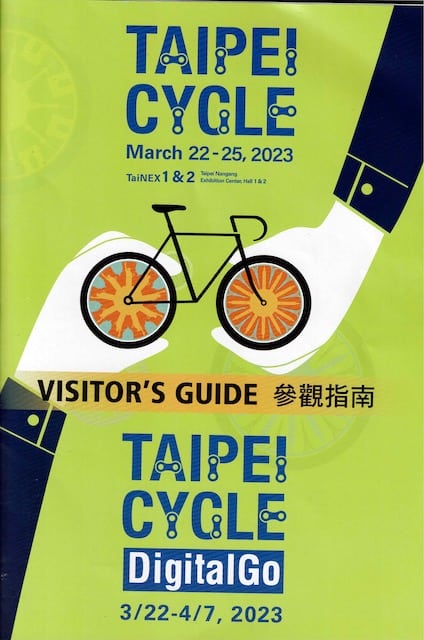
The Overseas Brands & Country Pavilions section category is the one to look for in the Taipei Cycle official guide book.
And on the subject of clusters generally speaking, Bicycle Cluster has become an important source for finding bike companies. Try it and see if it works for you.
Taipei Cycle to Move to Taichung by 2026?
The new Taichung International Convention and Exhibition Center is under construction in Taichung’s north, and is slated to be completed by 2025.
The 11,000 m2 occupies a smaller area than TaiNEX’s 47,000 m2 but certainly enough to accommodate Taipei Cycle.
Taichung’s mayor has said she thinks Taipei Cycle would most appropriately be relocated to Taichung given that 80% of Taiwan’s bicycle industry’s brands and factories are located within one hour’s drive of Taichung.
If the show were to be relocated to Taichung, international visitors could fly into Taichung’s International airport a few kilometers to the west.
But since that airport focuses on regional airlines and destinations, the most likely route would be via Hong Kong. In that case flying direct to Taoyuan and connecting to Taichung via the High Speed Rail service would probably be easiest.
Getting to the Nangang Exhibition Center
Wherever you are staying in Taipei, the most convenient way to get to TaiNEX is via the MRT.
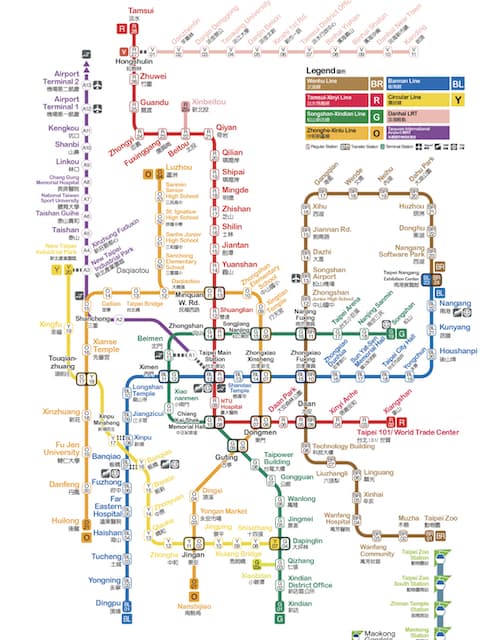
Taipei’s network of subway and elevated rail routes all make it easy to access the Blue line which terminates at TaiNEX: the Blue line is the one you head for wherever you are staying in Taipei.
d&i Awards
The design and innovation awards are now an integral part of Taipei Cycle, and are held in conjunction with the German organization, IF Design, established in 1953.
The Taipei Cycle d&i awards themselves were established in 2012 replacing the Innovative Products Competition Awards that preceded them.
The top 7 submissions earn a gold award with a Young Entrepreneur gold award for the most innovative product from a start up; a gold award acknowledging the most environmentally innovative product—the Green Prize—is also awarded.
What Was Different About This Year’s Taipei Cycle d&i Awards?
Two entrepreneurs new to the bicycle industry making quite a splash, that’s what.
There were close to 146 submissions this year with 39 winners overall, and seven winners of the prestigious gold award.
Each year the awards begin with award presentation culminating with the prestigious top seven products. Then follows a discussion amongst two or more participants.
Last year the discussants were KMC Chairman Robert Wu and a spokesman for Giant Bicycles (Here’s a report on last year’s d&i awardsby the way. . . juror Gideon Loewy’s comments are especially interesting) . . . a focus on the big players. Not so this year.
John Li’s Elxey
This year featured two young, new entrants into the bicycle industry: John Li who won the Young Enterprise gold award, and Alexandre Valette whose company, Gouach, received this year’s Green Prize.
This reflects the way the bicycle industry is transforming, as players with electrical and technical backgrounds move into the complete bicycles, and bicycle components vertical.
John’s remarks are a reality check for anyone thinking of entering the bike business, though.
“Don’t do it,” he advised the room with a chuckle whilst being deadly serious. “Looking back and knowing now how competitive the bike industry is, unless you have a really good idea, you should forget about it.”
The discussion then turned to that old topic of the need to love what you do. “Don’t start down this road for the money,” said John. “Only passion for what you are doing will give you the staying power.”
The moderator Kris Verstockt, one of this year’s d&i jurors remarked:
You should do something that you love doing. And when you love doing it, you’re going to get good at it. And when you get good at it, you will make money. It’s the proper way to think. Don’t start with the last part [about the money]. It won’t work.
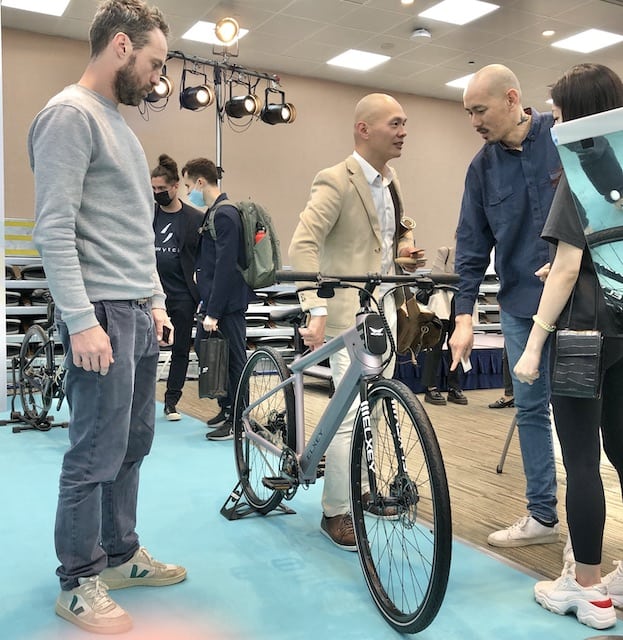
Alexandre Valette (left), the Green Prize winner, intently studies the Young Enterprise winning bike, Elxey.
That implies that a d&i award-winning design is destined for commercial success. Looking at the outcomes for past winners over the years, that assumption is not valid.
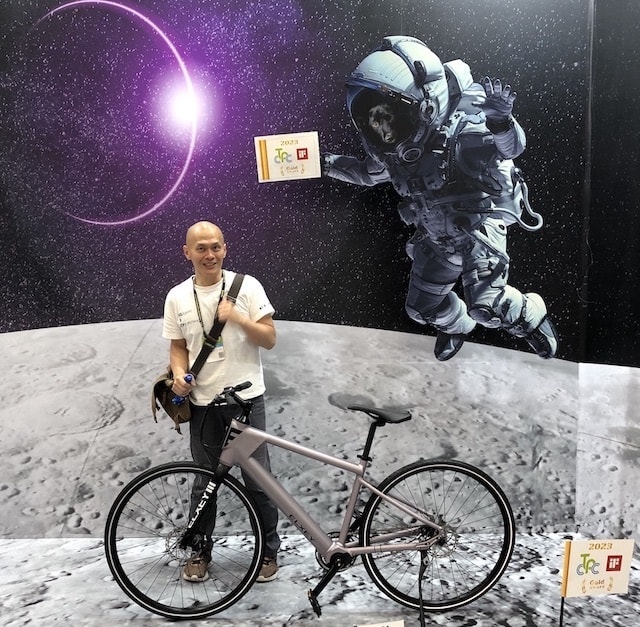
John’s Elxey city bike is an attractive bike with concealed cables and built-in tech such as power meters (necessary on a city bike?) and charging plug a rider accesses without having to bend down.
It’s likely that a version may find its way onto city streets around the world. But the market, like the moon, is harsh and unforgiving, so you would be looking to hedge your bets.
Alexandre Valette’s Gouach Replaceable Cell Battery
Given the dominance of e-bikes in the bike industry, breakthroughs in battery technology offer possibly the greatest opportunity to create a billion-dollar business.
And the R&D process through which Gouach developed their reusable battery is worthy of note—a massive amount of research with no guarantee of any positive outcomes.
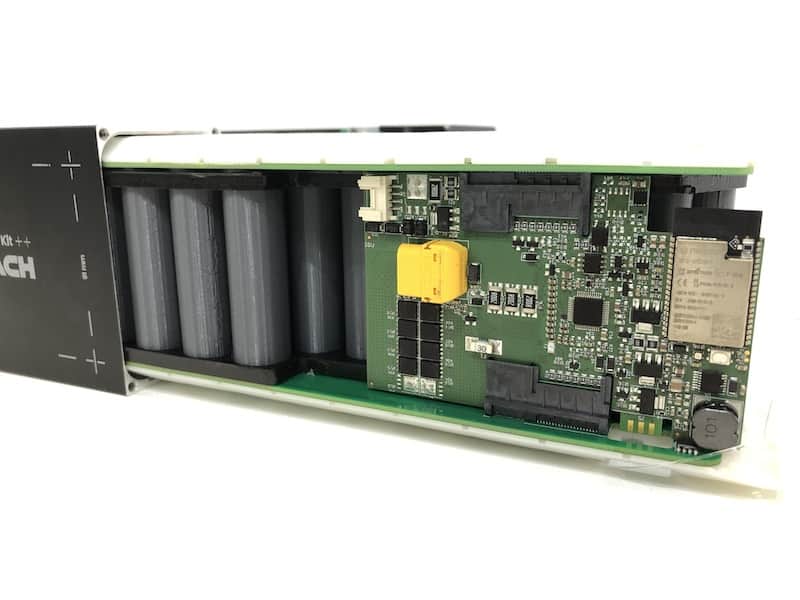
Method: they went to the trash and collected some 40 tons of discarded batteries, then dismantled each and every one including the 500,000 cells from which those batteries were constructed.
They discovered that 95% of the cells in those batteries were still good—replace the bad ones with new ones and the battery lives on.
The problem with conventional batteries is the way cells are interconnected. As Alexandre put it: “Cells are spot welded together[which] ensures the flow of the energy. It takes too much time to be economically viable to dismantle these cells. We worked for two years to create the first ecodesign battery, a battery where you can very easily dismantle every part of the battery.”
But the real key here is that by massively extending the life of an e-bike battery much better quality electronic components can be used so that “they never practically fail on the electronic side,” he says. “It’s a real game changer.”
Despite the accolades, the path to commercial success is by no means assured.
The big battery providers will be right onto the idea of replaceable cells. Even if this battery is patented, an R&D team at a big electronics company would likely be able to come with their own solution.
€ 3 million in funding has been used up and Gouach are hoping to “scale” their operation by connecting with a “big customer”, and the best result in this situation is probably to be acquired by such a customer—there are countless examples of these outcomes in big tech.
Bikes and Components from This Year’s Taipei Cycle
One of the great things about the show is being able to see
- where the bike industry is right now
- where it is headed in the future
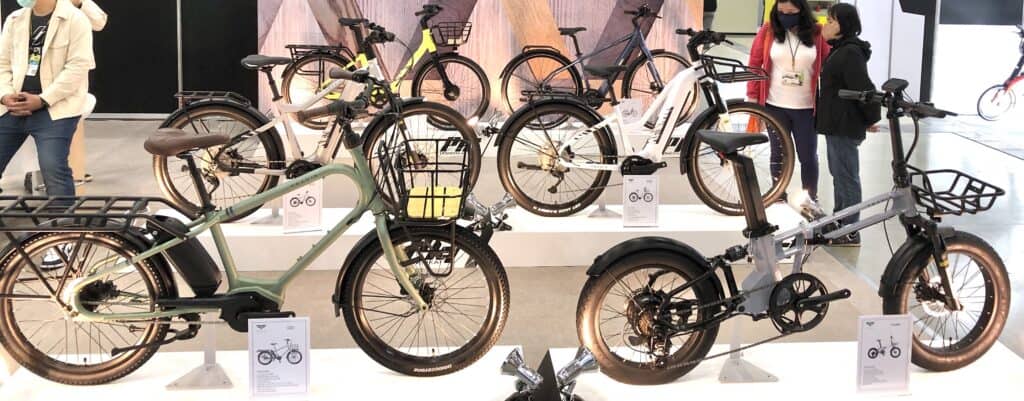
From all the booths in the show, this one captured a representative overview of e-bike design as of this year: step-through, small-wheel, fat-tire bikes with one or two folding bikes in the mix designed for the mass market (not niche groups like the MAMILS for example).
For where things are headed, the most instructive part of the show was 4F Area N where startups were clustered.
Here is a curated selection of kit from this corner of the show that is representative of where e-bike design and tech is headed.
Mid-Drive Motors
This year’s show was arguably all about the motors with a large number of companies exhibiting for the first time.
Valeo is a manufacturer of automative parts that has been in the business for 100 years.
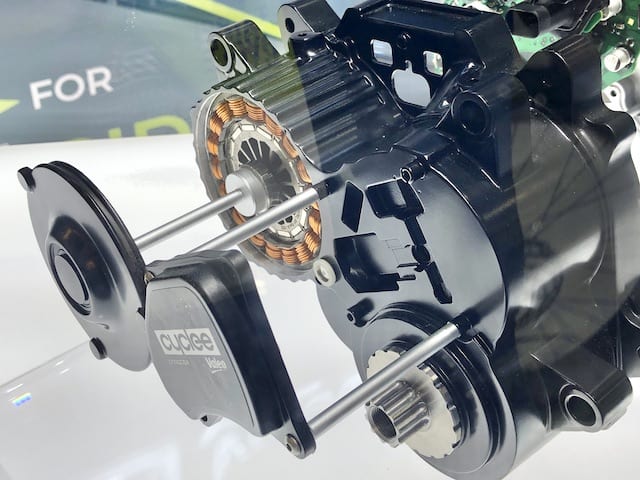
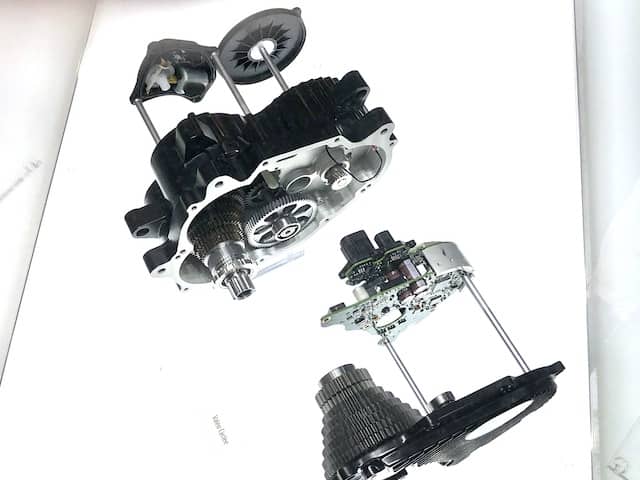
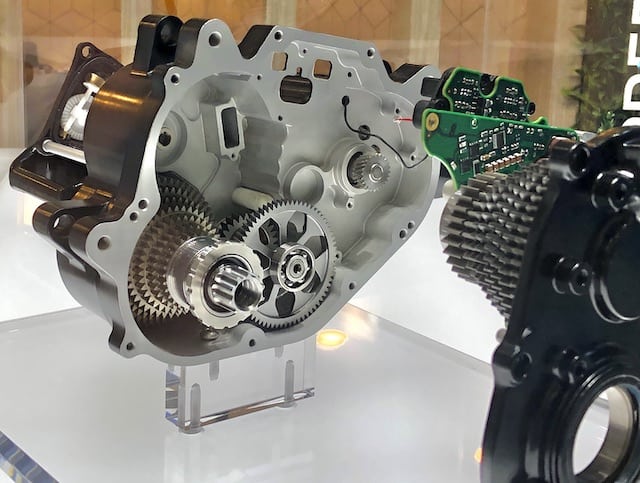
The Cyclee is a 48V single module containing an automatic gearbox and controlled through predictive software that adapts to a cyclist’s riding style.
The company have jumped into the e-bike space because the mobility space is undergoing the “biggest transformation in its history,” said the company’s Ebike Platform Director Benjamin Morliere.
This rationale is certainly shared amongst the legacy electronics companies that have all dived into e-bikes in the last five years or so, many of them exhibiting at Taipei Cycle for the first time.
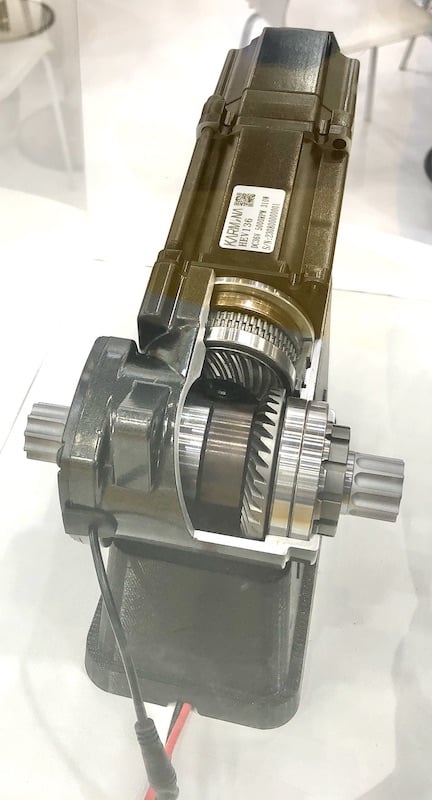
KH Gears exhibited their “harmonic gears” down tube mid-drive motor.
The motor incorporates a “new technique that makes the riding experience smoother” and more efficient according to the spokesperson at the booth.
They reason that since harmonic gearing is used in high-tech aerospace, medical device and robotic arm applications, why not in an e-bike drive?
Stone Motors set up in California in 1975 developing new battery technology. They jointly produced the world’s first AB₂ (Ni-MH) nickel-metal hydride battery production line in 1976.
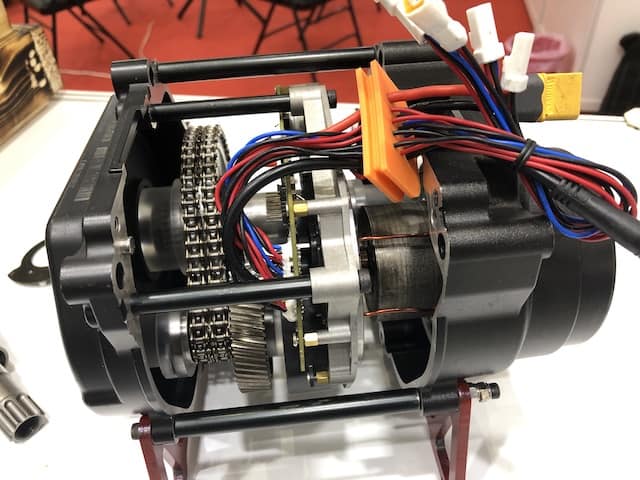
After decades working with mobile phone manufacturers and car makers, by 2020 they were manufacturing a range of electric motorcycles
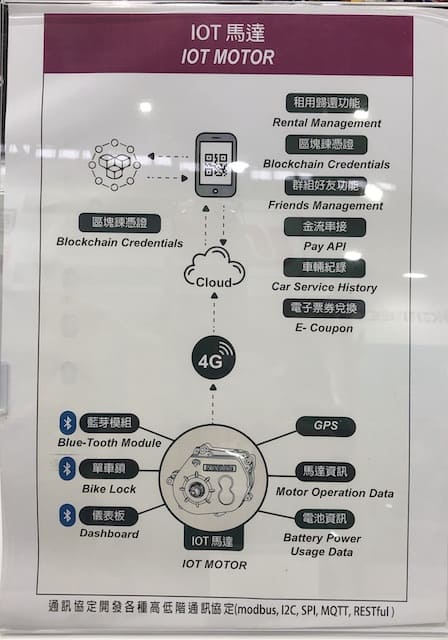
Showcasing a number of motors at this year’s Taipei Cycle, their presentation of a sophisticated system incorporating IoT and blockchain technology was eye-catching.
The 4G connectivity was a touch incongruous since 5G is well on the way with 6G set to be introduced shortly after—one of Taiwan’s biggest semiconductor design companies, for example, is working with compound semiconductors which communicate directly with each other rather than via a device.
Hyena claimed the lightest e-bike motor at Taipei Cycle this year.
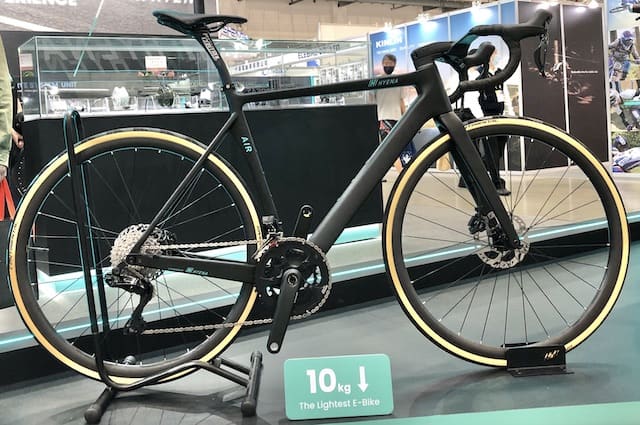
The return of a concern with weight was probably inevitable given the way it came to shape the market when carbon replaced alloy as the preeminent frame and component-building material during the late 2000s.
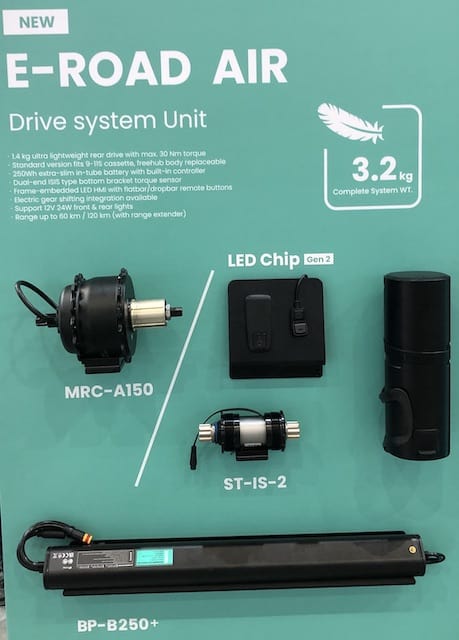
3.2kg is impressive—be prepared for a multi-year effort to reduce that number to a minimum.
Still, Hyena are one of the few companies to make weight their unique selling point—hardly anyone else mentioned it which does suggest that weight may not be all that important to the new cyclists that have either returned to cycling, or taken it up for the first time due to the widespread availability and increasing affordability of e-bikes.
Non-Electric Mid-drive Motor
After decades of seeing products come and go at the show, the “Environmental Assistance System” (EAS for short) is surely one of the most ingenious . . . and bizarre.
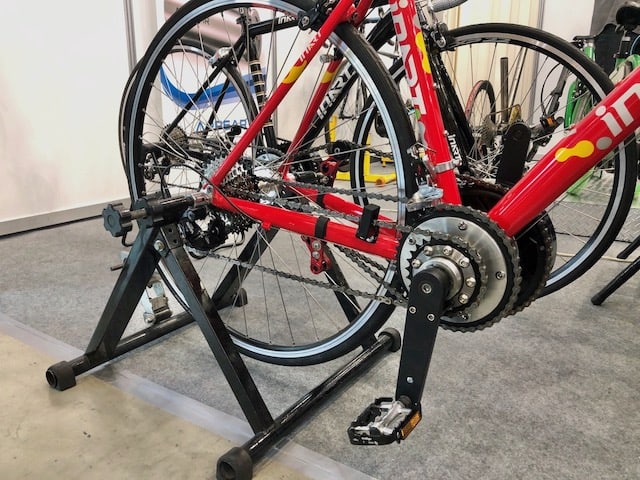
The idea is that pedaling compresses the spring, or something similar.
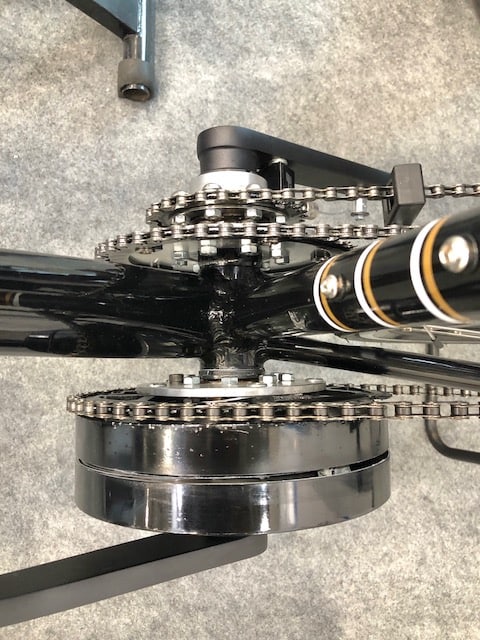
Then you ease off or stop pedaling altogether as the potential energy you have built up rockets you forward.
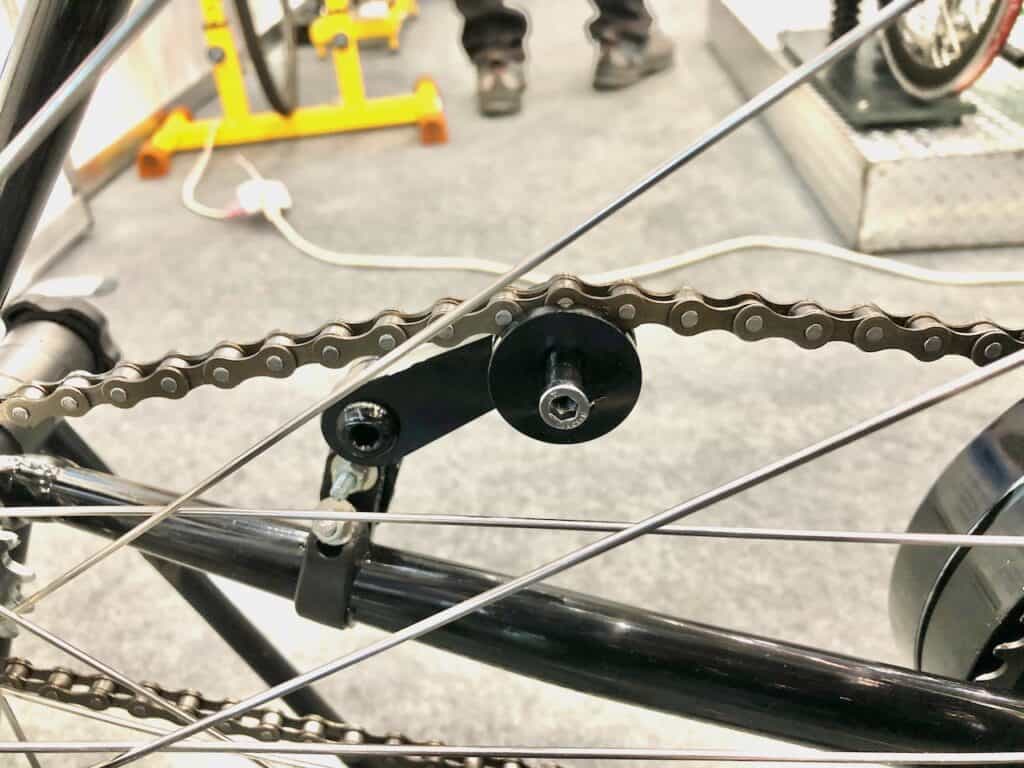
And don’t forget the guide wheel supporting the left side drive chain (the unit is technically left AND right drive).
Might be a novelty item for a bike hire company, found by a lake or a scenic recreational bike route, for example. And then again, it may tap into an unidentified niche and blindside everyone.
The whole design is reminiscent of the Magnat Debon rétro-direct from the early 20th century, in that period leading up to the establishment of the modern rear derailleur.
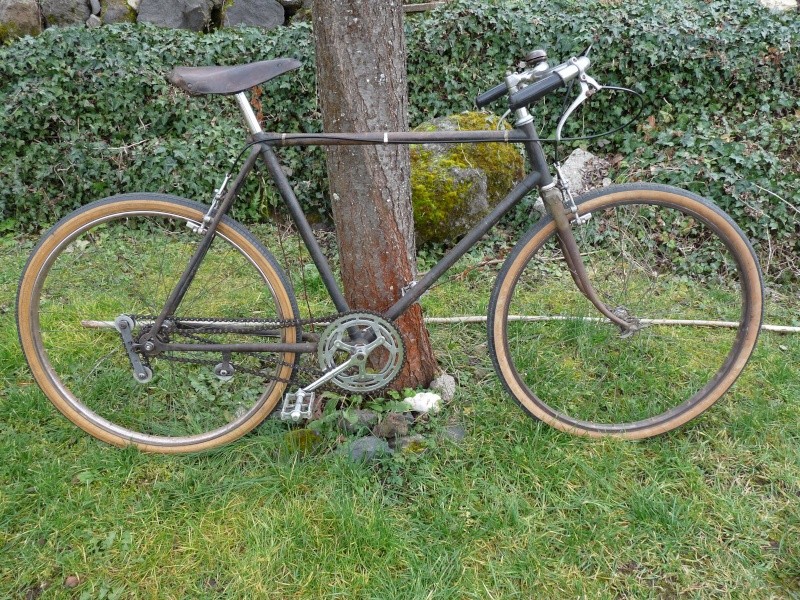
To what degree these principles have been perhaps re-invented in the development of the EAS drive, or inspired its development, is not clear.
Batteries
Innovations in battery durability and capacity will transform e-biking.
Right now (Q2 2023), two batteries (and in some cases, three) are extending the range and time between charges—the d&i award-winning Route Ohlala incorporated two large-capacity batteries at the direction of the controller.
Merry Electronics exhibited at Taipei Cycle for the first time and present a good contrast between how a giant legacy electronics manufacturer approaches ESG issues, compared with an under-capitalized start up, namely Gouach’s award-winning battery (d&i awards above) where individual cells can be replaced by the user thus reducing the need for battery disposal at all.
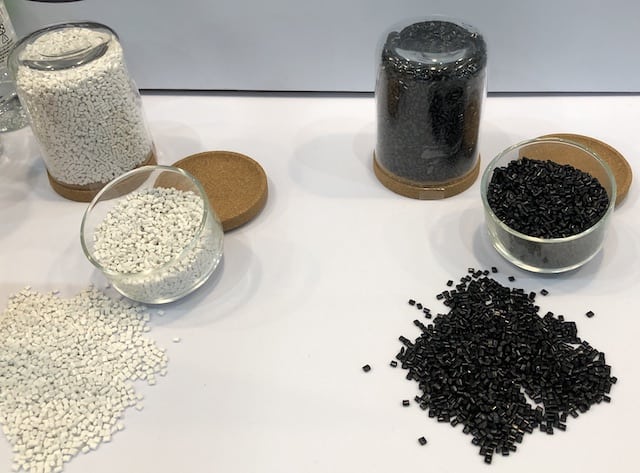
PCR or Post-Consumer Recycled plastic is, as the name suggests, formed out of plastics that can be re-used. They are reprocessed into a resin which forms the base for the plastic used in new products.
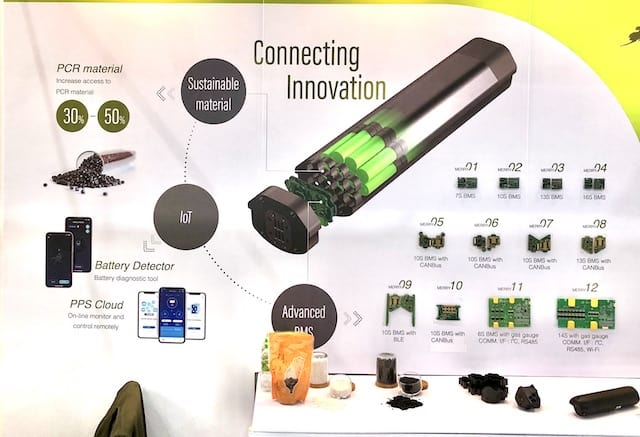
IoT to cloud integration is standard now and Merry’s USP appears to be only targeted at recycling and environmentally friendliness, ESG in other words.
The cells are anchored in the battery with this PCR material and we would assume that at the end of the battery’s life the plastic structure would be processed again as PCR and make its way into other products.

There’s clear daylight between Gouach’s innovation and Merry’s approach, especially since Gouach could also build their batteries out of PCR, and may well do so but have not mentioned it since the ability to replace individual cells and not have to recycle a battery—perhaps indefinitely—is the breakthrough innovation here.
Folding Bikes
A key advantage of a folding bike is it’s light . . . or should be since folding and lifting generally go together.
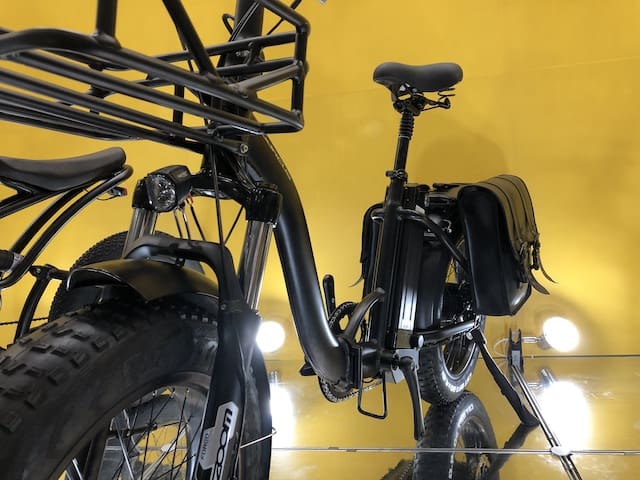
This was a common folding bike example in quite a few booths—a basic step-through with a central hinge and fat tires.
The bulky battery is lodged behind the seat tube as this is technically a cargo bike; those big tires plus the racks front and back are meant for carrying a lot of gear.
Folding into a small space is fine for this type of bike. But having to tote it upstairs will reduce its addressable market.
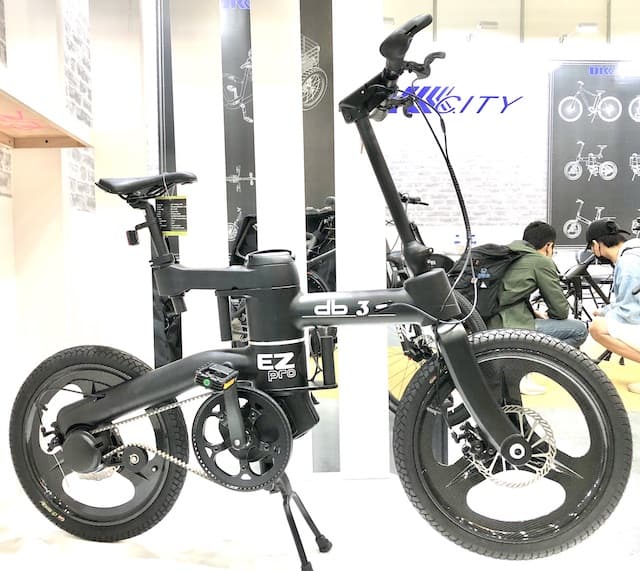
Contrast this with DK City’s EZ pro db 3: they’ve built the hinge around the battery in a well-presented, elegant belt drive, almost-fat-tire mid-drive motor folding bike that really stood out at the show.
They are first time exhibitors at Taipei Cycle although they have been exhibiting at TaiSPO (held concurrently with Taipei Cycle) for many years since they are a sporting equipment manufacturing company.
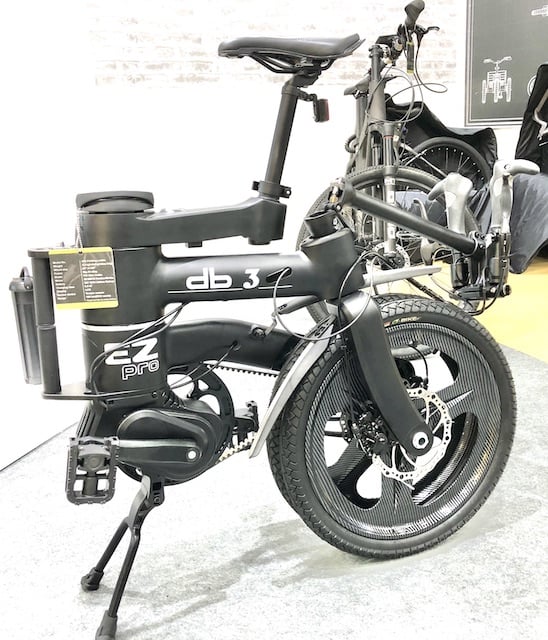
It’s as heavy as you’d expect for an e-folding bike—but no heavier.
Although getting it up a flight of stairs would still be a task for many people, it’s more doable.
Taipei Cycle 2024
The 2024 edition of Taipei Cycle will be late in the first week or early in the second week of March.
Each year the show alternates between early March and late March—this year was late March, so next year’s Taipei Cycle will be early in the month.
Bookmark this page and section because we’ll be updating it with news across the year.
